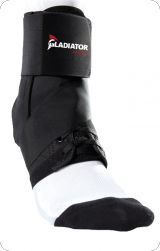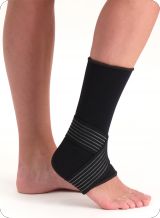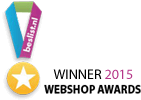Secured Lower Ankle Joint
Do you have a secured lower ankle joint? If so, then take a look at our Medical Team's selection of braces to best help you with this. Prefer additional information? Feel free to read on, we're more than happy to explain it to you.
Read more »
Which brace is best for you?
For your convenience we use 3 protection levels, that way you will always pick the right brace.
Level 1: Is colored green, and stands for Basic protection.
Level 2: Is colored orange, and stands for Advanced protection.
Level 3: Is colored red, and stands for Highest protection.
General information
In a joint, two or more bones come together. These are covered with a layer of cartilage which causes them to move smoothly. As you grow older, the cartilage in your joint will change in composition and thickness. Osteoarthritis means that excess wear of the cartilage is taking place. This will cause the layer of cartilage to disappear, causing the surface to become thin and crumbly. The body can not repare this on its own. The lower part of the ankle is the joint between the heel bone and the talus. This functions as the sideways mover in the rear foot. The upper part of the ankle joint is important for the backward movement.
Causes
There are about four causes
- Osteoarthritis can occur after having suffered from a different disorder, think of a bone fracture. The cartilage can get damaged by moving in a different way.
- Incorrect foot stance can also cause osteoarthritis. Think of a flat foot or hollow foot (Pes Planus, Pes Cavus).
- A reaction to an inflammation can also damage the cartilage, think of Rheumatoid Arthritis.
- The cartilage layer is damaged by an unknown cause. Which will eventually expose the bone.
Complaints
- Stance deviation
- Pain when resting
- Swelling
- Movement limitation
- Stiffness
- Pain when moving
Treatment
Personal history and a physical examination are usually enough for a specialist to diagnose Osteoarthritis. An X-ray can confirm this diagnosis. An MRI scan is usually not necessary. However, a CT scan can be made to assess the nearby joints. Non-surgical as well as surgical treatments can be performed. Non-surgical treatment can include painkillers, anti-inflammatory drugs, physiotherapy, an injection of corticosteroids, a walking stick to ease walking, customized shoes, braces and tape. When it comes to the last two, we have many different products for sale to help you with this. If your complaints do not decrease after treatment, you could always choose to undergo surgery.












